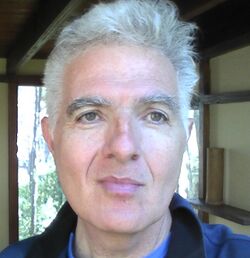Biography:Ariel Fernandez
Ariel Fernandez | |
|---|---|
 2016 | |
| Born | April 8, 1957 Bahía Blanca, Argentina |
| Citizenship |
|
| Alma mater |
|
| Known for | Dehydrons |
| Scientific career | |
| Fields | |
| Institutions | |
| Thesis | Structural Stability of Chemical Systems at Critical Regimes (1984) |
| Doctoral advisor | Oktay Sinanoğlu |
| Website | www |
Ariel Fernandez (born Ariel Fernández Stigliano, April 8, 1957) is an Argentinian–American physical chemist and pharmaceutical researcher.[1]
Education and early career
Fernandez received Licentiate degrees in Chemistry (1979) and Mathematics (1980) from the Universidad Nacional del Sur, Argentina.[1] He then earned a Ph.D. from Yale University in 1984 with a thesis entitled Structural Stability of Chemical Systems at Critical Regimes[2][1]
Career
Fernandez held the Karl F. Hasselmann Professorship of Bioengineering at Rice University until 2011.[3][better source needed] He is a member of the National Scientific and Technical Research Council (CONICET) in Argentina.[4]
Fernandez developed the concept of the dehydron, an adhesive structural defect in a soluble protein that promotes its own dehydration.[5] The nonconserved nature of protein dehydrons has implications for drug discovery, as dehydrons may be targeted by highly specific drugs/ligands.[6] This technology was applied by Fernandez and collaborators to design a new compound based on the anticancer drug Gleevec, in order to reduce its cardiotoxicity.[7][8] In laboratory tests, the new compound was similar to Gleevec in inhibiting gastrointestinal stromal tumors, but without toxic effects on cardiac cells, although it lacked Gleevec's inhibitory effects on leukemia cells.[8]
The editorial board of the Proceedings of the National Academy of Sciences retracted a January 2006 paper coauthored by Fernandez because it had "substantial overlap", without attribution, of figures and text from an article by Fernandez published in Structure the previous month, a form of duplicate publication.[9] The website Retraction Watch has documented incidences of scientific concerns about some of Fernandez's other publications, claims that Fernandez has denied.[10]
Awards
Fernandez was awarded a Camille Dreyfus Teacher-Scholar Award for early-career researchers in 1991;[11] a Guggenheim Fellowship for researchers in Latin America and the Caribbean in 1995;[12] and was elected a Fellow of the American Institute for Medical and Biological Engineering for his "contributions to understanding protein folding and protein-protein interactions and the use of this knowledge to design new drugs", in 2006.[13]
Books
- Transformative Concepts for Drug Design: Target Wrapping, by Ariel Fernández (ISBN:978-3642117916, Springer-Verlag, Berlin, Heidelberg, 2010).
- Biomolecular Interfaces, by Ariel Fernández Stigliano (ISBN:978-3319168494, Springer-Verlag, Berlin, Heidelberg, 2015).
- Physics at the Biomolecular Interface, by Ariel Fernández (ISBN:978-3319308517, Springer International Publishing AG, Switzerland, 2016).[14]
- A Mathematical Approach to Protein Biophysics, by L. Ridgeway Scott and Ariel Fernández (ISBN:978-3319660318, Springer, 2017).
- Artificial Intelligence Platform for Molecular Targeted Therapy: A Translational Science Approach, by Ariel Fernández (ISBN:978-9811232305, World Scientific Publishing Co., 2021).
- Topological Dynamics in Metamodel Discovery with Artificial Intelligence: From Biomedical to Cosmological Technologies, by Ariel Fernández (ISBN:978-1032366326, Chapman & Hall/CRC Press, UK, 2022).
- Artificial Intelligence on Dark Matter and Dark Energy: Reverse Engineering of the Big Bang, by Ariel Fernández (ISBN:978-1032465548, Chapman & Hall/CRC Press, UK, 2023).
References
- ↑ 1.0 1.1 1.2 Ariel Fernandez. "Ariel Fernandez CV and Biographical Narrative". Academia.edu. https://www.academia.edu/6141377.
- ↑ Ariel Fernandez. Yale University Dissertation: Structural Stability of Chemical Systems at Critical Regimes (Dissipative Structures, Potential Energy Surfaces). Published/Created:1984
- ↑ "Administration and faculty", Catalog 2010–2011, Rice University, http://www.rice.edu/catalog/2010_2011/PDF/09_AdministrationFaculty.pdf, retrieved December 2, 2014.[|permanent dead link|dead link}}]
- ↑ "Comunicación - Conicet". CONICET. http://www.conicet.gov.ar/new_scp/detalle.php?keywords=&id=33676&datos_academicos=yes.
- ↑ Monroe, Dan (2012). "Proteins Hook up Where Water Allows". Physics 5 (51): 51. doi:10.1103/Physics.5.51. Bibcode: 2012PhyOJ...5...51M. http://physics.aps.org/articles/v5/51. Retrieved June 23, 2021.
- ↑ Crunkhorn, Sarah (2008). "Anticancer drugs: Redesigning kinase inhibitors". Nature Reviews Drug Discovery 7: 120–121. doi:10.1038/nrd2524. http://www.nature.com/nrd/journal/v7/n2/full/nrd2524.html.
- ↑ Demetri G. D. Structural reengineering of imatinib to decrease cardiac risk in cancer therapy.2007 Dec 3; J Clin Invest. 117(12):3650–3653. doi 10.1172/JCI34252 [1]
- ↑ 8.0 8.1 Dunham W. Reworked Gleevec curbs heart-related complication. REUTERS December 3, 2007 [2]
- ↑ Cozzarelli, Nicholas R. (March 14, 2006). "Retraction for Fernández et al., Packing defects as selectivity switches for drug-based protein inhibitors". Proceedings of the National Academy of Sciences, USA 103 (11): 4329. doi:10.1073/pnas.0601034103. PMID 16505348. Bibcode: 2006PNAS..103.4329C.
- ↑ Kolowich, Steve (September 25, 2015). "Meet Retraction Watch, the Blog That Points Out the Human Stains on the Scientific Record". The Chronicle of Higher Education. https://www.chronicle.com/article/meet-retraction-watch-the-blog-that-points-out-the-human-stains-on-the-scientific-record/?cid=reg_wall_signup&bc_nonce=y0vgyz858xcl6uc7u84qx.
- ↑ "Camille Dreyfus Teacher-Scholar Awards Program Past Awards". http://www.dreyfus.org/announcements/PAST-TC.pdf.
- ↑ "Ariel Fernández". Fellows. John Simon Guggenheim Memorial Foundation. http://www.gf.org/fellows/all-fellows/ariel-fernandez/. Retrieved September 27, 2012.
- ↑ "College of Fellows". Members. American Institute for Medical and Biological Engineering. http://aimbe.org/college-of-fellows/cof-0289/. Retrieved September 27, 2012.
- ↑ Dobson, Peter J. (September 2017). "Review of Physics at the Biomolecular Interface". Contemporary Physics (Informa {UK} Limited) 58 (4): 369. doi:10.1080/00107514.2017.1371227. Bibcode: 2017ConPh..58..369D.
 |

